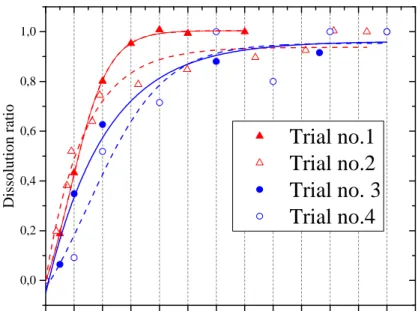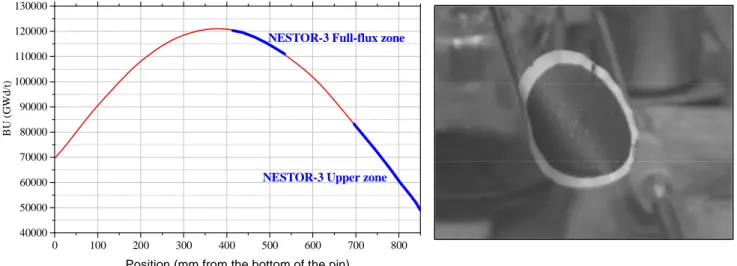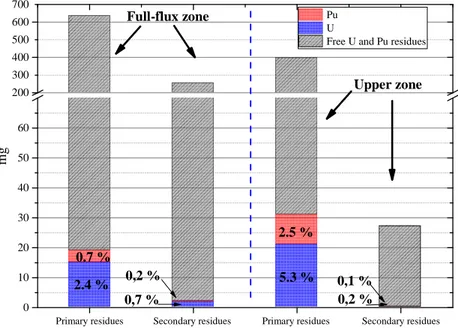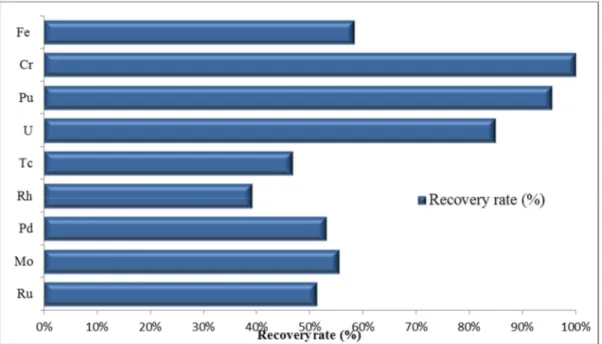HAL Id: hal-02419693
https://hal.archives-ouvertes.fr/hal-02419693
Submitted on 19 Dec 2019
HAL is a multi-disciplinary open access archive for the deposit and dissemination of sci-entific research documents, whether they are pub-lished or not. The documents may come from teaching and research institutions in France or abroad, or from public or private research centers.
L’archive ouverte pluridisciplinaire HAL, est destinée au dépôt et à la diffusion de documents scientifiques de niveau recherche, publiés ou non, émanant des établissements d’enseignement et de recherche français ou étrangers, des laboratoires publics ou privés.
dissolving spent sfr mox fuel in nitric acid
E. Buravand, N. Reynier-Tronche, B. Catanese, P. Huot, E. Esbelin, S.
Grandjean, M. Crozet, X. Machuron-Mandard
To cite this version:
E. Buravand, N. Reynier-Tronche, B. Catanese, P. Huot, E. Esbelin, et al.. First assessment of a digestion method applied to recovery of plutonium from refractory residues after dissolving spent sfr mox fuel in nitric acid. International Conference on Fast Reactors and Related Fuel Cycles: Next Generation Nuclear Systems for Sustainable Development (FR17), Jun 2017, Yekaterinburg, Russia. �hal-02419693�
First assessment of a digestion method applied to recovery of plutonium
from refractory residues after dissolving spent SFR MOX fuel in nitric acid
E. Buravand, N. Reynier-Tronche, B. Catanese, P. Huot, , E. Esbelin, S. Grandjean, M. Crozet, X. Machuron-Mandard 1
1
CEA, Nuclear Energy Division, Reasearch Department on Mining and Fuel Recycling Processes, F-30207 Bagnols sur Ceze, France.
E-mail contact of main author: emilie.buravand@cea.fr
Abstract: Given the initial plutonium content in SFR MOX fuel, its quantitative recovery is one of the main
objectives for the global dissolution process. A silver (II) oxidative digestion step was studied in the Atalante facility to assess its possible application to the treatment of undissolved residues obtained after dissolving spent SFR MOX fuel in nitric acid. This process was first optimized on plutonium dioxide powders, and then pretested on irradiated LWR MOX fuel residues. The digestion step permitted the recovery of up to 99% of the residual plutonium contained in the undissolved tiny particles, with some slight differences depending on the position of the pin part from which the dissolution residue was obtained. Local burnup and chemical composition were found to be influential. The quantity of residues after digestion was also significantly reduced thanks to this complementary treatment, with the final residues consisting mainly of metallic compounds including ruthenium, molybdenum, rhodium or palladium.
Key Words: recycling, residues, digestion, plutonium, waste.
1. Introduction
In order to improve nuclear energy sustainability, in particular through more efficient use of uranium resources, a French R&D Program for Plutonium Multi-Recycling has been developed. The full use of uranium resources means treatment and recycling of mixed uranium-plutonium fuels primarily burnt in Fast Reactors (FR) [1] [2]. However, materials containing large amounts of plutonium such as mixed uranium-plutonium oxide fuels (MOX) are more difficult to dissolve in nitric media because the oxidation potential of HNO3
solutions is insufficient to oxidize Pu(IV) into Pu(VI), and more aggressive dissolution conditions could lead to stainless steel cladding corrosion with consequences on waste downstream.
Three methods have been reported for the dissolution of plutonium dioxide [3], [4], [5], [6]: quantitative dissolution using strong complexants like hydrofluoric acid, reductive dissolution using chromium(II), or oxidative dissolution using cerium (IV), cobalt (III) or silver (II). Dissolution in presence of fluoride ions is generally undesirable in an industrial process because of its corrosive nature. Reductive dissolution using Cr (II) is not possible in the industrial media, i.e. nitric acid, due to the oxidative character of nitrous acid. The most widely used method to dissolve dioxide plutonium is therefore oxidative dissolution, with an electron transfer agent or mediator in the solution, i.e. an ion couple capable of fast, reversible electron transfer at sufficiently higher oxidation potential than the Pu(IV)/Pu(VI) couple (1,095 V/SHE) for example Ce(III)/Ce(IV), Co(II)/Co(III) or Ag(I)/Ag(II). This often involves using an electrochemical process to regenerate the mediator. In the literature, assessment of this kind of process has been done on non-irradiated material, like the French
electrogenerated Ag (II) carried out in the La Hague plant [7].
In this context, a silver (II) oxidative digestion step was studied at the Atalante facility in Marcoule to assess its possible application to the treatment of irradiated undissolved residues containing plutonium and fission products (FP). The digestion method was first tested on plutonium dioxide powder and next validated on irradiated LWR MOX fuel residues. It was then applied to the solid residues obtained after dissolving irradiated pin parts from an SFR PHENIX assembly in nitric media [8], with determination of the plutonium recovery rate and a study of key parameters, as well as quantification and characterization of the remaining residues.
2. Experimental
All the solutions of acids and alkalis were prepared using distilled water and analytical pure grade materials. Ag(I) solutions were prepared by dissolving a weighed portion of chemically pure grade AgNO3 in HNO3 at the required concentration.
The solid materials used for the trials were: AgO powder,
PuO2 powder (specific surface area of 8-9 m²/g),
Stainless steel hulls from the cladding of a SFR Phenix spent fuel plenum pin (Burnup (BU) 156 GWd/t),
Residues obtained after the primary dissolution of LWR MOX fuel (MOX A assembly: 3% Pu content, 22 GWd/t, MOX B assembly: 6% Pu content , BU: 7 GWd/t; primary dissolution of 25 mm length rod section in boiling nitric acid (8 M) for 8 hours, residue filtration by a 0.45 micron filter, rinsing),
Residues from the dissolution of SFR MOX fuel (NESTOR-3, 22.5 % Pu content, 124 GWd/t, primary dissolution of approximately 120 mm long rod sections in boiling nitric acid (8 M) for 6 hours, residue filtration on 0.45 µ porosity cellulose ester filter, rinsing, drying 4 hours at 70°C and calcination for 8 hours at 800°C).
The oxidative digestion step was mainly carried out at room temperature in concentrated HNO3 under stirring. A few hundred milligrams of solid were involved per test. The test durations depended on the plutonium dissolution steady state. Some experiments were performed in presence of diluted dissolution solution MOX fuel.
FIG. 1. Oxidative digestion setup.
After oxidative digestion, remaining residues were separated from the solution by a 0.3 micron filter, followed by rinsing with nitric acid, drying and weighing.
In order to quantify the remaining plutonium in these so-called secondary residues, complementary dissolutions were done: nitrofluorhydric dissolution or alkaline melting to also determine the residues’ elementary composition.
FIG. 2. Dissolution process flow diagram (simplified).
The plutonium and uranium concentrations in solution were measured by X-ray Fluorescence. Fission products were quantified in solution by ICP-AES spectrometry. The activities of alpha and gamma emitters were also determined.
The plutonium digestion step efficiency was calculated using equation 1: Gaseous trapping Digester
residues in Pu Total solution digestion in contained Pu (%) rate recovery Pu = (Equation 1)
3. Results and discussion 3.1.PuO2 digestion trials
The Ag(II) oxidative digestion was applied to a plutonium dioxide powder first alone, and then in presence of stainless steel from SFR spent fuel cladding and/or fission products from a MOX fuel dissolution solution (see TABLE I). The presence of stainless steel and FPs must be taken into account in the retreatment of fast reactor spent fuel. They can interfere in the plutonium digestion reaction for dissolution residues, a chemical reaction involving the oxidation of all the elements whose redox potential is less than that of the Ag(I)/Ag(II) couple (1,980 V/SHE)
TABLE I : EXPERIMENTAL CONDITIONS OF PLUTONIUM DIOXIDE POWDER DIGESTION
Test no. [HNO3] (mol/L)
[Pu]final (mol/L) [Stainless
steel] (g/L) [FP]* (g/L) 1 4 4.10-3 0 0 2 4 4.10-3 20 0 3 4 9.10-3 0 1.4 4 4 7.10-3 20 1.4
* Diluted dissolution solution
In the experimental conditions total plutonium dissolution was not significantly impacted fromthe stainless steel added to the medium (see FIG. 3. Trial no.1 vs no.2). In presence of diluted dissolution solution, i.e. mainly fission products, the digestion rate of PuO2 was a little
lower than without FPs, probably due to some competitive reactions. Adding stainless steel impacted the initial kinetic, but the steady state was reached in approximately the same time, given the estimated uncertainties.
FIG. 3. Dissolution ratios of PuO2 digestion step.
3.2.LWR MOX fuel residue digestion
The oxidative digestion was assessed for irradiated LWR MOX fuel residues in concentrated HNO3 for 9 hours under stirring. Remaining residues were dissolved in nitrofluorhydric
media to quantify undissolved plutonium and determine the Pu digestion yield.
The MOX A assembly was the least irradiated and the lowest in fission products with 75% of plutonium by weight in residues. Up to 92% of the plutonium was dissolved by digestion (see TABLE II). The Pu digestion yield was higher than the most irradiated MOX B assembly, which had a plutonium recovery rate of 67.4%. A plutonium enrichment of MOX B residues could be seen through the chemical steps, from 34.5% to 64.6%, indicating both strong plutonium heterogeneities and an accessibility problem as the oxidative digestion reaction occurred at the solid surface.
TABLE II : EXPERIMENTAL DATA OF LWR MOX RESIDUE DIGESTION
BU (GWd/t) Residue Pu content (by weight (%)) [Residue] in the digester (g/L) Pu digestion yield (%) Pu/(U+Pu)1 (%) Digestion step Nitrofluorhy dric step MOX A 7 74.7 2.4 92.8 72.3 1 73.7 1 MOX B 22 8.5 2.4 67.4 34.5 2 64.6 2
1Pu/(U+Pu) dissolution solution ratio = 4.1 % , 2 Pu/(U+Pu) dissolution solution ratio = 2.5 %
In these experimental conditions, the fission products and the different fuel manufacturing processes (resulting in greater or lesser plutonium heterogeneities) both strongly influence the residue digestion. 0,0 0,2 0,4 0,6 0,8 1,0
Trial no.1
Trial no.2
Trial no. 3
Trial no.4
D is so lu ti o n r at ioThe oxidative digestion was applied to undissolved residues which remained after dissolving irradiated pin parts from the PHENIX NESTOR-3 assembly in nitric media. Given past experiment results, and in order to obtain new basic data, the whole pin was not dissolved but only separate sections with known local burnups [8]. Digestion step assessments for residues in the full-flux zone and the upper zone were carried out (see FIG.5.).
FIG. 4. Local burnup of NESTOR-3 dissolved pin parts
Residue Pu content was lower for the full-flux zone (FFZ) than the upper zone (UZ) (see TABLE III).
TABLE III : MAIN DATA FOR SFR MOX NESTOR-3 RESIDUES DIGESTION
NESTOR-3 Full-flux zone BU range: 124-115 GWd/t [Residue] in the digester: 3.9 g/L
NESTOR-3 Upper zone BU range: 86-58 GWd/t [Residue] in the digester: 2.2 g/L
Residue Pu content (% by weight) Pu yield (%) Pu/(U+Pu)1 (%) Residue Pu content (% by weight) Pu yield (%) Pu/(U+Pu)2 (%) Digestion step 0.7 95.4 23.8 2.5 99.8 32.1 Complementary step(s) 5.4 34.6 0.2 29.0
1 Pu/(U+Pu) fuel dissolution solution = 21.2 % ; 2 Pu/(U+Pu) fuel dissolution solution = 20.5 % [8]
Erasing of initial fuel plutonium heterogeneities with an upper linear power density during irradiation could be an explanation. This hypothesis seems to be confirmed by Pu/(U+Pu) ratios higher than the dissolution solution ratio of the fuel.
From 95.4 up to 99.8% of plutonium was dissolved by the oxidative digestion. Plutonium accessibility did not seem to be limited in these residues.
FIG. 5. Residues before oxidative digestion
0 100 200 300 400 500 600 700 800 40000 50000 60000 70000 80000 90000 100000 110000 120000 130000
NESTOR-3 Upper zone NESTOR-3 Full-flux zone
B U ( G W d /t )
The lowest plutonium dissolution yield was from the most irradiated part with the lowest Pu content, i.e. in the NESTOR-3 full-flux zone. Its high fission product content could be the main factor influencing digestion efficiency. Three types of fission product precipitates were identified by destructive Post Irradiation Examinations (PIEs) performed at the CEA-Cadarache: oxide precipitate composed of Ba-Zr-Mo-O-U-Pu-Am and metallic precipitates including Mo, Ru, Rh, Pd, Tc, Pd, Ag or, in smaller quantities, precipitates including Te-Pd-Ag-Rh [9]. A different axial distribution of metallic fission products was observed, these elements being included in large metallic precipitates at the full-flux part of the pin. The plutonium digestion yield could be impacted by these compounds. It must be remembered that the oxidative Ag(II) digestion is a non-selective chemical reaction oxidizing redox potential elements less than Ag(I)/Ag(II) couple. Furthermore, it can be seen that depending on the zone (see FIG. 7), the dissolved residue percentages fluctuate. More than 93% of residues were dissolved by digestion for the upper zone, compared to 60% for the full-flux zone. The fission product dissolution was thus limited for the higher fission product content zone, i.e. the full-flux zone.
FIG. 7. U and Pu residue content before (primary residues) and after (secondary residues) digestion.
The full-flux zone residues were also full characterized, and chemical elements dissolved by the digestion step were quantified. The recovery rate was normalized for the quantified total mass (see FIG. 8.).
Primary residues Secondary residues Primary residues Secondary residues
300 500 700 0 10 20 30 40 50 60 200 400 600 0,2 % 0,1 % 2.5 % 5.3 % 0,2 % 0.7 % 0,7 % Upper zone m g Pu U
Free U and Pu residues Full-flux zone
FIG. 8. Recovery rate of the NESTOR-3 full-flux zone residue elements.
From 40% to 60% of the metallic compounds were dissolved, including up to 50% of Fe and 100% of Cr (cladding components). Ru, Mo, Rh, Pd, and Tc were found in large quantities in these residues, the same elements as those identified in metallic precipitates.
4. Conclusion
Higher plutonium concentrations in SFR MOX fuel require specific process steps to prevent plutonium retention in residues at the front end of the recycling cycle. More aggressive dissolution conditions can lead to cladding corrosion with consequences on the waste to deal with downstream. A complementary digestion method was first tested on plutonium dioxide powder, then validated on irradiated LWR MOX fuel residues and applied to solid residues obtained after dissolving irradiated pin parts from a PHENIX NESTOR-3 assembly in nitric media.
The silver (II) digestion method permitted the recovery of up to 99% of residual plutonium, with some slight differences depending on the position of the pin part from which the dissolution residue was obtained. Fission products and especially metallic compounds were found to be slightly influential but not limiting. In addition, the quantity of residues after digestion was significantly reduced, by 60% up to 90%, thus reducing the impact on industrial waste conditioning needs downstream. The remaining residues mainly consisted of metallic elements, e.g. ruthenium, molybdenum, rhodium or palladium.
The R&D will be continued and applied to different SFR MOX fuel residues, studying the impact of fuel plutonium initial enrichment or burnup. The experimental method consisting of the dissolution of separate sections to better understand phenomena due to high chemical differences between sample locations on a SFR MOX fuel pin will be also validated.
5. Acknowledgments
The authors wish to thank AREVA NC for its financial support within the CEA-AREVA NC joint programs. The authors also wish to thank the analysis laboratories of the Atalante facility.
6. References
[1] GRANDJEAN, S., et al., “French R&D program for multirecycling of plutonium”, International conference: Fast reactors and related fuel cycle (FR13), (2015).
[2] Treatment and recycling of spent fuel, Monographie DEN, Editions le Moniteur (2008). [3] BOURGES, J., MADIC, C., LESS,J., Comm. Metals, 122 (1986) 303-311.
[4] MADIC, C., et al., “Mechanisms of the Rapid Dissolution of Plutonium Dioxide in Acidic Media under oxidative or reducing conditions”, American Chemical Society, 44 (1992) 457-468.
[5] RYAN, J.L, BRAY, L.A, “Dissolution of Plutonium Dioxide -A critical Review”, Actinide Separations, American Chemical Society 34 (1980) 499-513.
[6] BRAY, L.A, RYAN, J.L, “Catalyzed electrolytic dissolution of plutonium dioxide”, Radioactive waste management 6 (1982) 129-154.
[7] French patent 95 10428
[8] REYNIER-TRONCHE, N., et al., « A comprehensive study of the dissolution of spent SFR MOX fuel in boiling nitric acid (the PHENIX NESTOR-3 case)”, This conference (FR17)
[9] LAMONTAGNE, J., “Nestor 3 experiment: destructive post irradiation examinations on pin 110”, FP7-Fission-2013 - Combination of Collaborative project (CP) and Coordination and Support Actions (CSA) - Grant agreement no: 605172
European Commission - ESNII plus – Deliverable D732 – revision 0 issued on 30/06/2015
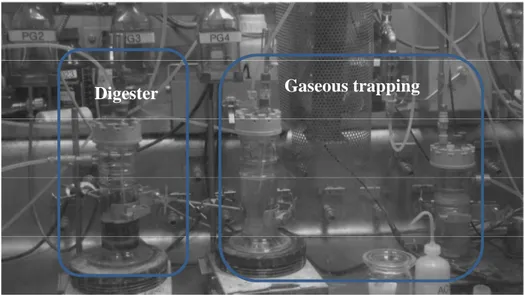
![TABLE I : EXPERIMENTAL CONDITIONS OF PLUTONIUM DIOXIDE POWDER DIGESTION Test no. [HNO 3 ]](https://thumb-eu.123doks.com/thumbv2/123doknet/12892475.370732/5.892.128.761.508.677/table-experimental-conditions-plutonium-dioxide-powder-digestion-test.webp)
